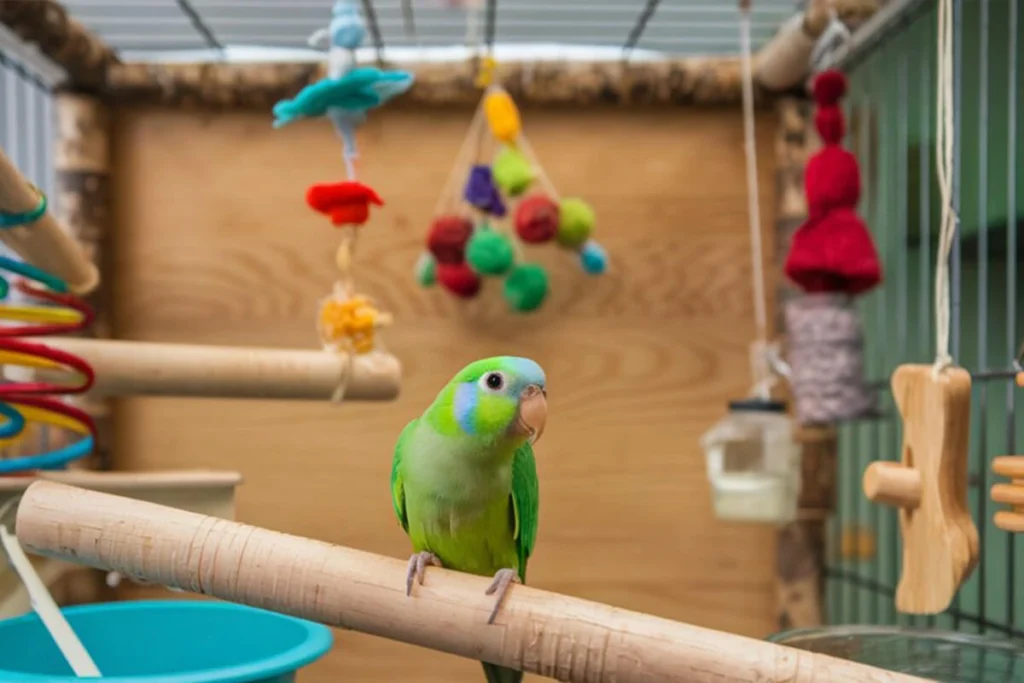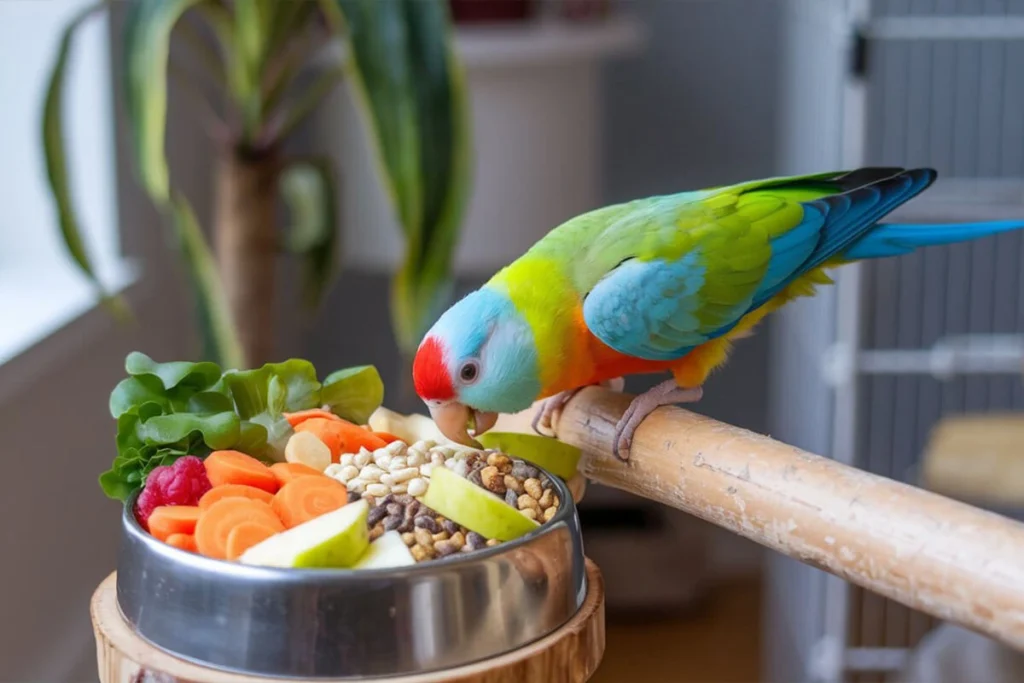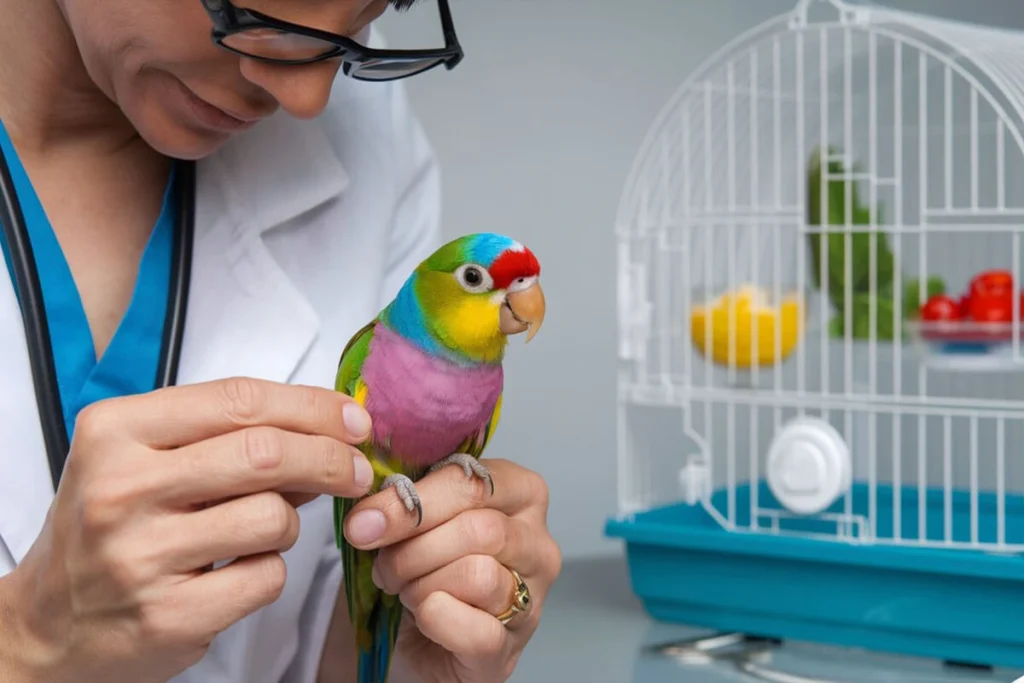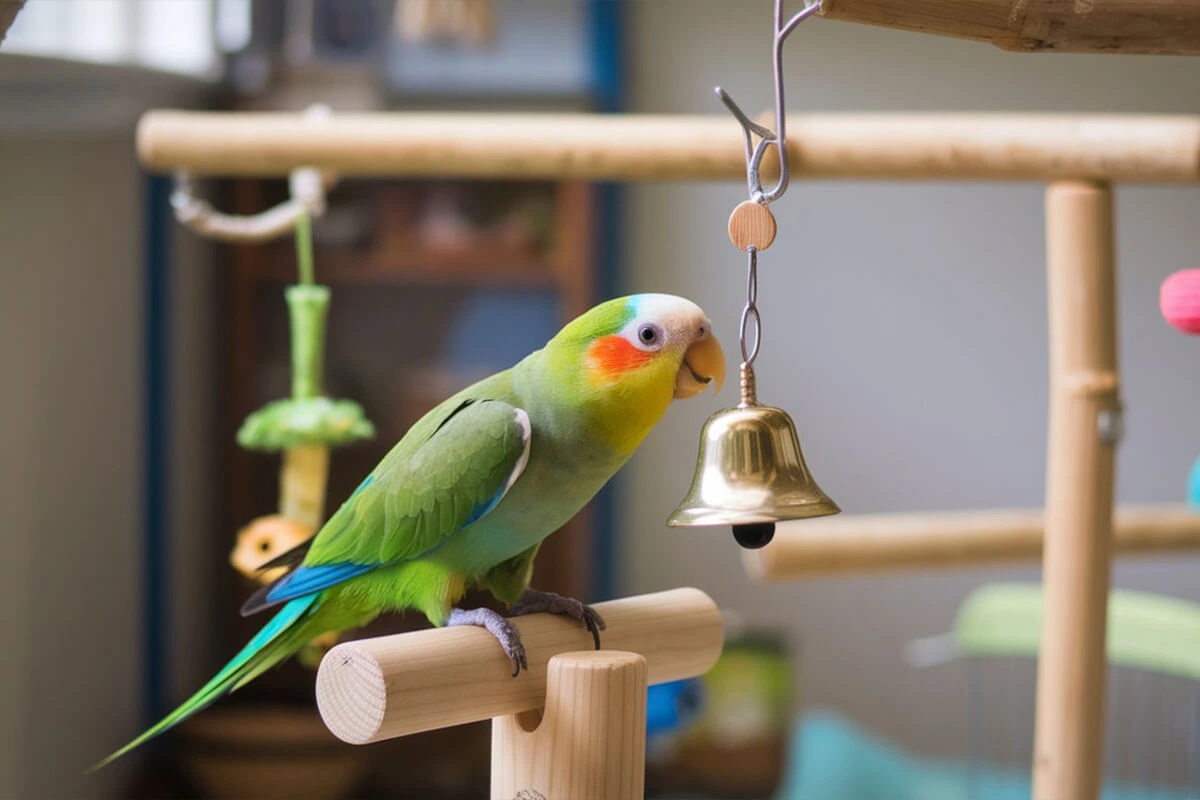Mexican Parrotlets (Forpus cyanopygius) make wonderful companions for bird lovers who want a small, intelligent, and playful pet. These tiny parrots, native to Mexico, have big personalities despite their small size. They love interacting with their owners, exploring their environment, and learning new tricks. However, caring for a Mexican Parrotlet requires proper knowledge of its diet, habitat, and social needs.
Providing the right care ensures that your feathered friend lives a happy and healthy life for 10 to 20 years. A well-balanced diet, an enriching environment, and regular training help your parrotlet thrive. Without proper care, these birds can develop behavioral and health problems, such as feather plucking or nutritional deficiencies.
In this guide, you’ll learn everything you need to know about Mexican Parrotlet care, from choosing the best diet to setting up the perfect cage. You’ll also discover effective training tips, common health concerns, and ways to keep your bird mentally and physically stimulated. Whether you’re a first-time owner or looking to improve your bird’s well-being, these ten essential tips will help you create the best life for your parrotlet.
Setting Up the Perfect Cage for Your Mexican Parrotlet
Choosing the Right Cage Size
A Mexican Parrotlet may be small, but it needs plenty of space to move, stretch its wings, and stay active.A small cage can make animals feel anxious, bored, and can even cause health problems. Choose a cage that is at least 18 inches wide, 18 inches deep, and 24 inches tall, but bigger is always better. Since parrotlets love to climb and explore, opt for a cage with horizontal bars to encourage natural movement. Bar spacing should be no more than ½ inch to prevent your bird from squeezing through or getting stuck.
If you plan to house more than one parrotlet, increase the cage size significantly. Even bonded pairs need space to retreat from each other when necessary. A flight cage provides extra room for exercise and helps keep your parrotlet active and entertained.
Essential Cage Accessories For Mexican Parrotlet
A bare cage won’t keep your Mexican Parrotlet happy. You need to add perches, toys, food and water dishes, and enrichment items to create a comfortable and stimulating home.

- Perches – Offer a variety of perch sizes and textures, including natural wood branches, rope perches, and textured perches. Different perches keep your bird’s feet strong and prevent pressure sores.
- Toys – Mexican Parrotlets are playful and intelligent, so give them a mix of chew toys, foraging toys, bells, and swings. Rotate toys weekly to keep things exciting.
- Cuttlebone and Mineral Blocks – These provide essential calcium for strong bones and a healthy beak.
- Food and Water Dishes – Securely attach stainless steel or ceramic bowls to the cage. Avoid plastic dishes, as they can harbor bacteria.
A well-equipped cage keeps your parrotlet entertained and reduces the risk of stress-related behaviors like excessive squawking or feather plucking.
Ideal Cage Placement
Where you place the cage affects your parrotlet’s well-being. Keep the cage in a quiet but social area where your bird can interact with family members without being overwhelmed. Avoid high-traffic zones like the kitchen, where cooking fumes and sudden noises can stress your bird.
Here are some key placement tips:
- Avoid direct sunlight and drafts – Too much heat or cold can make your parrotlet sick. Keep the cage away from open windows, air conditioners, and heaters.
- Provide natural light – Birds need a regular day-night cycle to stay healthy. Place the cage in a room with natural light, but make sure your bird has a shaded area to rest.
- Keep it at eye level – A cage placed too high may make your bird feel dominant, while a low cage can make it feel vulnerable. Eye level helps your parrotlet feel safe and connected to you.
A well-placed cage helps your parrotlet feel secure, relaxed, and ready to bond with you.
Best Diet for a Healthy Mexican Parrotlet
Primary Food Sources
Feeding your Mexican Parrotlet a well-balanced diet ensures long-term health and vitality. In the wild, these birds eat a mix of seeds, fruits, and vegetation, so their diet in captivity should closely mimic their natural eating habits.
A high-quality parrotlet seed mix or pellet formula should make up the base of their diet. Choose a mix specifically designed for small parrots, avoiding blends that contain artificial colors, added sugars, or excessive sunflower seeds. Pellets provide essential nutrients in a balanced form, while seeds offer variety and encourage foraging behavior.
Don’t rely solely on seeds, as an all-seed diet can lead to malnutrition and vitamin deficiencies. Combine seeds or pellets with fresh vegetables, fruits, and supplements to keep your parrotlet healthy and energetic.

Fruits and Vegetables For Mexican Parrotlet
Fresh fruits and vegetables add vital nutrients, antioxidants, and hydration to your parrotlet’s diet. Offer a variety of leafy greens, crunchy vegetables, and vitamin-rich fruits to keep meals interesting and nutritious.
Best vegetables for your Mexican Parrotlet:
- Dark leafy greens (kale, spinach, dandelion greens) – Provide calcium and iron.
- Bell peppers (red, yellow, green) – Rich in vitamin C and antioxidants.
- Carrots – Support eye health with beta-carotene.
- Broccoli – A great source of fiber and vitamins.
Best fruits for your Mexican Parrotlet:
- Apples (seedless) – A tasty, fiber-rich snack.
- Bananas – Soft and easy to eat, packed with potassium.
- Berries (blueberries, strawberries, raspberries) – High in antioxidants.
- Mango and papaya – Provide natural enzymes that aid digestion.
Fruits and vegetables to avoid:
- Avocado (toxic and potentially fatal).
- Onion and garlic (harmful to a bird’s digestive system).
- Rhubarb (contains toxic compounds).
- Citrus fruits (can be too acidic in large amounts).
Wash all produce thoroughly and chop it into small, manageable pieces. Offer a mix of fruits and veggies daily, removing uneaten portions after a few hours to prevent spoilage.
Importance of Fresh Water and Supplements For Mexican Parrotlet
Mexican Parrotlets need constant access to clean, fresh water. A dehydrated bird can quickly develop health issues, so check and refill the water dish at least twice a day. Use a stainless steel or ceramic water dish to prevent bacterial buildup, and wash it daily to keep it free from contaminants.
Supplements play a key role in maintaining your bird’s health, especially if its diet lacks variety. Cuttlebone and mineral blocks provide essential calcium, helping with bone strength and beak maintenance. If your parrotlet doesn’t get enough natural vitamin D from sunlight, consider adding a vitamin D3 supplement or using a full-spectrum UVB light to support calcium absorption.
Some parrotlets benefit from probiotics and omega-3 supplements, especially if they have digestive issues or feather health concerns. Always consult an avian vet before introducing new supplements to ensure your bird gets the right balance of nutrients.
By offering a diverse diet, clean water, and necessary supplements, you’ll help your Mexican Parrotlet stay healthy, active, and full of energy.
Training and Taming Your Mexican Parrotlet
Building Trust Through Interaction
Earning a Mexican Parrotlet’s trust takes patience, consistency, and positive interaction. These small birds form strong bonds with their owners, but they need time to feel comfortable in a new environment. If you rush the process, your parrotlet might become fearful or defensive.
Start by spending time near the cage without forcing interaction. Let your parrotlet observe you and get used to your presence. Talk softly to reassure your bird that you mean no harm. Do not move suddenly or make loud sounds because this might scare it.

Once your parrotlet seems relaxed around you, begin offering treats through the cage bars. Millet spray, small fruit pieces, or sunflower seeds work well as rewards. This helps your bird associate your hand with positive experiences.
After a few days of successful treat-giving, open the cage door and let your parrotlet come to you. Never grab or chase your bird, as this destroys trust. Instead, extend your hand slowly with a treat and allow it to step forward when ready. Over time, your parrotlet will learn that you’re a source of comfort, food, and fun.
Basic Training Commands
Mexican Parrotlets are highly intelligent and love learning simple tricks and commands. Training strengthens your bond, prevents boredom, and improves behavior.
- Step-Up Command
- Hold your index finger in front of your parrotlet’s feet.
- Say “Step up” in a gentle but firm voice.
- If your bird hesitates, lightly touch its lower chest to encourage movement.
- Reward with a treat immediately after it steps onto your finger.
- Recall Training (Flying to You on Command)
- Start by placing your parrotlet on a perch and standing close by.
- Hold a treat and say “Come here” or “Fly to me” while extending your arm.
- When your bird moves toward you, reward it with praise and a treat.
- Gradually increase the distance as your parrotlet gains confidence.
- Target Training
- Use a small stick or chopstick as a target.
- Hold the stick near your parrotlet and wait for it to touch it with its beak.
- Reward immediately when your bird makes contact.
- Use target training to guide your parrotlet onto perches, your hand, or play areas.
Training should always be short and fun—5 to 10 minutes per session is ideal. If your parrotlet seems frustrated or distracted, take a break and try again later.
Avoiding Common Behavioral Issues
Mexican Parrotlets have strong personalities and can develop bad habits if their needs aren’t met. Understanding the root causes of problem behaviors helps prevent long-term issues.
Biting
Parrotlets may bite when they feel threatened, overstimulated, or territorial. To prevent biting:
- Avoid forcing interactions—let your bird come to you willingly.
- Watch for warning signs like fluffed feathers, a defensive stance, or lunging.
- Use positive reinforcement instead of scolding. Reward calm behavior with treats and praise.
Excessive Squawking
Parrotlets are naturally vocal, but constant loud squawking signals boredom, loneliness, or stress. To reduce noise:
- Ensure your bird gets enough out-of-cage time and mental stimulation.
- Keep a consistent daily routine to provide security and predictability.
- Avoid reinforcing screaming by giving attention only when your parrotlet is quiet.
Feather Plucking
Plucking can be a sign of stress, nutritional deficiencies, or illness. If your parrotlet starts pulling out feathers:
- Check for potential stressors like lack of social interaction or environmental changes.
- Improve diet with more fresh vegetables, fruits, and calcium supplements.
- Schedule a vet visit to rule out medical conditions like infections or skin irritations.
By addressing problem behaviors early, you’ll create a positive, trusting relationship with your parrotlet while ensuring it stays happy and well-adjusted.
Maintaining Your Parrotlet’s Health
Common Health Issues
Mexican Parrotlets are hardy birds, but they can develop health problems if their diet, environment, or hygiene isn’t properly managed. Knowing the most common health issues helps you prevent serious complications and take quick action when necessary.

Psittacosis (Parrot Fever)
Psittacosis, caused by the Chlamydia psittaci bacteria, is a serious respiratory infection that can spread to humans. Affected birds may show symptoms like difficulty breathing, nasal discharge, lethargy, and diarrhea. If you notice these signs, take your parrotlet to an avian vet immediately for antibiotics.
Feather Plucking
Feather plucking is a common behavioral issue that can result from stress, boredom, nutritional deficiencies, or underlying medical conditions. If your bird starts pulling out feathers, assess its environment. Lack of stimulation, poor diet, or a stressful cage setup may be the cause. Increasing interaction, providing more enrichment, and improving nutrition often help. If the problem persists, consult a vet to rule out skin infections or parasites.
Respiratory Infections
Cold drafts, smoke, or poor air quality can lead to respiratory infections. Symptoms include wheezing, sneezing, nasal discharge, tail bobbing (labored breathing), and loss of appetite. Keep your parrotlet away from cigarette smoke, strong household chemicals, and sudden temperature changes. If you notice respiratory issues, a vet may prescribe antibiotics or supportive care.
Nutritional Deficiencies
A seed-only diet leads to calcium, vitamin A, and protein deficiencies, causing weak bones, poor feather condition, and a weakened immune system. Ensure your bird eats a balanced diet of pellets, fresh vegetables, and fruits, with cuttlebone or mineral blocks for added calcium.
Beak and Nail Overgrowth
A healthy bird naturally wears down its beak and nails while eating and climbing. If you notice an overgrown beak or long, curling nails, your bird may need a better diet, more natural perches, or a professional trim from a vet.
Signs of a Healthy vs. Sick Bird
Mexican Parrotlets hide illness well, a survival instinct from the wild. As an owner, you must recognize subtle signs of sickness before they become serious.
Signs of a Healthy Bird:
- Bright, alert eyes and responsive behavior
- Smooth, well-groomed feathers with no bald spots
- Active and playful, showing curiosity about its surroundings
- Eating and drinking regularly
- Droppings that are firm and consistent in color (green, white, and a small amount of clear liquid)
Signs of a Sick Bird:
- Fluffed-up feathers for long periods (a sign of discomfort)
- Sitting at the bottom of the cage or becoming inactive
- Loss of appetite or refusing favorite foods
- Labored breathing, wheezing, or tail bobbing
- Changes in droppings (diarrhea, discolored poop, or blood)
- Sudden weight loss or an overgrown beak
If your parrotlet shows any of these signs, don’t wait—take it to an avian vet as soon as possible. Birds can deteriorate quickly when sick, so early intervention saves lives.
Regular Vet Visits and Grooming
A healthy parrotlet needs at least one annual checkup with an avian vet. Routine visits help detect early signs of illness and ensure your bird receives proper nutrition and care. If your bird has a history of health issues, more frequent visits may be necessary.
What to Expect During a Vet Visit:
- Weight check to monitor overall health
- Beak, nails, and feather inspection for abnormalities
- Bloodwork or stool tests if any health concerns arise
- Recommendations on diet, supplements, and enrichment
Grooming Needs for a Mexican Parrotlet
Nail Trimming: In the wild, birds naturally wear down their nails while climbing. In captivity, nails may become too long, making it difficult to grip perches. If nails start curling or scratching you, a vet or experienced handler should trim them.
Beak Maintenance: A healthy beak should stay smooth and even. Chewing cuttlebone, mineral blocks, and wooden toys helps keep it in shape. If the beak becomes overgrown, an avian vet should trim it.
Feather Care: Mexican Parrotlets love to bathe. Provide a shallow water dish or gently mist your bird with lukewarm water to keep feathers clean and hydrated. Bathing also helps prevent dry skin and reduces dust buildup.
By maintaining regular vet visits, monitoring health changes, and providing proper grooming, you’ll keep your Mexican Parrotlet in top condition, ensuring a long, happy life.
Keeping Your Mexican Parrotlet Happy and Stimulated
Providing Mental and Physical Enrichment
Mexican Parrotlets are highly intelligent and active birds that need daily mental and physical stimulation. Without enough enrichment, they can develop boredom-related behaviors like feather plucking, excessive squawking, or aggression. Keeping your parrotlet engaged ensures a happy and well-adjusted pet.
Toys and Puzzles
Parrotlets love to chew, climb, and manipulate objects. A variety of chew toys, shreddable materials, foraging puzzles, and bells keeps them entertained. Rotate toys regularly to maintain interest and challenge their problem-solving skills. Natural wood, leather, and paper-based toys encourage safe chewing while mimicking foraging behaviors in the wild.
Out-of-Cage Playtime
A cage, no matter how spacious, cannot provide enough exercise for an active parrotlet. At least 1–2 hours of supervised playtime outside the cage helps strengthen muscles, improve coordination, and prevent obesity. Set up a safe area with perches, ropes, ladders, and bird-safe play stands to encourage exploration and movement.
Flight and Exercise Opportunities
Flying is essential for a parrotlet’s physical and mental health. If possible, allow free flight in a bird-proofed room to help build confidence and agility. If free flight isn’t an option, encourage exercise through climbing structures, foot toys, and hanging swings inside the cage. Teaching recall training or engaging in short flying sessions strengthens the bond between you and your bird while keeping it fit.
Socialization Needs
Mexican Parrotlets are social, interactive birds that thrive on companionship and engagement. Without proper socialization, they can become withdrawn, aggressive, or overly dependent on their owners.
Interacting with Your Parrotlet
Daily interaction builds trust and prevents behavioral issues. Talk to your bird throughout the day in a gentle, enthusiastic voice. Offer treats by hand, play games, and encourage step-up training to establish a strong bond. Positive interactions help reduce anxiety and make handling easier.
Introducing New Experiences
Exposing your parrotlet to new sounds, objects, and people in a controlled way helps prevent fear-based behaviors. Move the cage to different rooms, introduce safe household sounds, and let your bird observe daily activities. Gradual exposure to new environments increases confidence and prevents phobias.
Multi-Bird Households
Some owners consider getting a second parrotlet for companionship. While this can be beneficial, not all parrotlets get along. If you introduce a second bird, keep them in separate cages at first and allow supervised interactions. Observe their body language and reactions to ensure compatibility.
Preventing Loneliness and Stress
Parrotlets are prone to stress if left alone for long periods. A bored or lonely bird may develop destructive habits, excessive vocalization, or self-harming behaviors like feather plucking. Preventing stress ensures a well-balanced, emotionally healthy bird.
Consistent Daily Routine
A structured daily schedule provides comfort and predictability. Feed your bird, clean the cage, and interact at consistent times each day. A routine reduces anxiety and helps your parrotlet feel secure in its environment.
Environmental Stimulation
A dull environment leads to stress. Provide a variety of perches, textures, mirrors, and interactive toys to keep your bird engaged. Place the cage near a window (but out of direct sunlight or drafts) to offer an interesting view of the outside world. Playing soft music or bird sounds can also provide a sense of companionship when you’re not home.
Avoiding Over-Attachment
Parrotlets form deep bonds with their owners, but excessive attachment can lead to separation anxiety. Encourage independent play and self-entertainment by giving foraging toys, food puzzles, and chewable objects. If your bird constantly demands attention, gradually increase periods of alone time to help it feel comfortable when you’re away.
By providing mental and physical enrichment, socialization, and a stress-free environment, you’ll help your Mexican Parrotlet lead a happy, fulfilling life.
Conclusion
Caring for a Mexican Parrotlet requires commitment, patience, and an understanding of its unique needs. These small but intelligent birds thrive in environments that provide proper nutrition, mental and physical stimulation, social interaction, and regular healthcare. By meeting these needs, you ensure that your parrotlet remains happy, healthy, and engaged throughout its life.
A well-balanced diet, including high-quality pellets, fresh fruits, and vegetables, helps maintain strong immunity and energy levels. Fresh water and essential supplements support overall health, while avoiding a seed-only diet prevents nutritional deficiencies. Pairing a spacious cage with engaging accessories like perches, toys, and ladders keeps your parrotlet active and entertained. Daily out-of-cage playtime encourages movement and strengthens the bond between you and your pet.
Building trust through positive interactions and gentle training ensures a well-socialized bird. Avoiding common behavioral issues, such as excessive biting or feather plucking, requires patience and consistency. Providing a stimulating environment with rotating toys, interactive play, and a structured daily routine helps prevent loneliness and stress. Mexican Parrotlets are social creatures that need attention, but fostering independence also prevents over-attachment and separation anxiety.
Regular vet visits play a crucial role in keeping your parrotlet in peak condition. Watching for early signs of illness, maintaining proper grooming, and ensuring a stress-free environment contribute to a long, fulfilling life for your feathered companion.
With the right care, your Mexican Parrotlet will reward you with years of companionship, playful energy, and affectionate interactions. By understanding and meeting its needs, you create a nurturing home where your parrotlet can truly thrive.
Discover the Top 10 Small Parrots for New Owners Here.
Discover The Purple Parrot Birds From Here.
Find Out More about Other Pets and breeds From HERE!
Find Out the Best stuff for your Pet On Pet MD Official.

2 thoughts on “Mexican Parrotlet Care: 10 Essential Tips for a Happy, Healthy Pet”
Comments are closed.